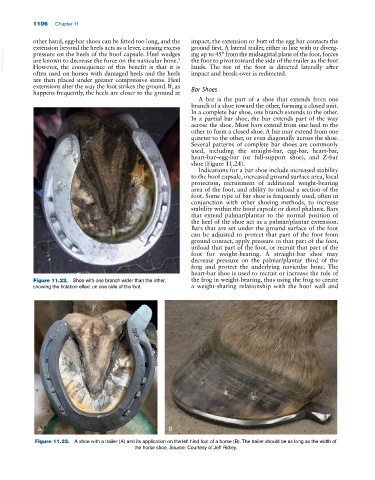Page 1140 - Adams and Stashak's Lameness in Horses, 7th Edition
P. 1140
1106 Chapter 11
other hand, egg‐bar shoes can be fitted too long, and the impact, the extension or butt of the egg bar contacts the
extension beyond the heels acts as a lever, causing excess ground first. A lateral trailer, either in line with or diverg
VetBooks.ir are known to decrease the force on the navicular bone. the foot to pivot toward the side of the trailer as the foot
ing up to 45° from the midsagittal plane of the foot, forces
pressure on the heels of the hoof capsule. Heel wedges
5
lands. The toe of the foot is directed laterally after
However, the consequence of this benefit is that it is
often used on horses with damaged heels and the heels impact and break‐over is redirected.
are then placed under greater compressive stress. Heel
extensions alter the way the foot strikes the ground. If, as Bar Shoes
happens frequently, the heels are closer to the ground at
A bar is the part of a shoe that extends from one
branch of a shoe toward the other, forming a closed unit.
In a complete bar shoe, one branch extends to the other.
In a partial bar shoe, the bar extends part of the way
across the shoe. Most bars extend from one heel to the
other to form a closed shoe. A bar may extend from one
quarter to the other, or even diagonally across the shoe.
Several patterns of complete bar shoes are commonly
used, including the straight‐bar, egg‐bar, heart‐bar,
heart‐bar–egg‐bar (or full‐support shoe), and Z‐bar
shoe (Figure 11.24).
Indications for a bar shoe include increased stability
to the hoof capsule, increased ground surface area, local
protection, recruitment of additional weight‐bearing
area of the foot, and ability to unload a section of the
foot. Some type of bar shoe is frequently used, often in
conjunction with other shoeing methods, to increase
stability within the hoof capsule or distal phalanx. Bars
that extend palmar/plantar to the normal position of
the heel of the shoe act as a palmar/plantar extension.
Bars that are set under the ground surface of the foot
can be adjusted to protect that part of the foot from
ground contact, apply pressure to that part of the foot,
unload that part of the foot, or recruit that part of the
foot for weight‐bearing. A straight‐bar shoe may
decrease pressure on the palmar/plantar third of the
frog and protect the underlying navicular bone. The
heart‐bar shoe is used to recruit or increase the role of
Figure 11.22. Shoe with one branch wider than the other, the frog in weight‐bearing, thus using the frog to create
showing the flotation effect on one side of the foot. a weight‐sharing relationship with the hoof wall and
A B
Figure 11.23. A shoe with a trailer (A) and its application on the left hind foot of a horse (B). The trailer should be as long as the width of
the horse shoe. Source: Courtesy of Jeff Ridley.

